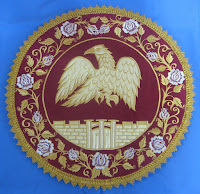Not that many months ago I didn’t have a clue what an orphrey was. Now I’m designing them.
If you had mentioned a galloon back then, I might have snickered. Not anymore. Even though I am still very much a novice in the world of church vestments and paraments, I’ve learned to pay attention and ask questions.
 |
| Original Six Chief Parts drawing. Copyright © Edward Riojas |
What I’ve also learned is the work is fascinating, and I think you’ll agree after this peek at the process behind producing the lovely offerings of Ecclesiastical Sewing. Shortly after Carrie Roberts launched her small company, she asked me to collaborate with her on some projects. My function is to act as designer, primarily creating images for use on embroideries that adorn her products.
Besides creating original designs, I also help resurrect old ones. That in itself can be challenging. Like an archaeological site, some designs are incomplete or partially destroyed. It sometimes falls to me to fill in the missing pieces through simple logic or artistic conjecture. One project on the back-burner, for example, involves recreating a scene of the stoning of St. Stephen for the back of a chasuble. All that exists is a delicate pencil drawing, done in classical, academic style. A third of the drawing has been torn off and is lost forever.
 |
| Adobe Illustrator screen shot, wire frame view. Copyright © Edward Riojas |
Old designs come to me in the form of photos, as in the case of the torn drawing, or as digital files. Some of the files are “rastered” images – basically, digitized images that have been converted to photos – or they come as “vectored” images – editable designs that are comprised of shapes. The latter are easiest to alter and color, while the former need complete redrawing in an illustration application. It can be mind-numbing work, but it’s a thrill to bring old designs back to life and know that they will once again be appreciated.
New designs are another matter. A general directive for a design is first given by Roberts – perhaps for a new Reformation “set.” A set is a group of associated designs that can be used in every application necessary in the chancel. While not every church needs every application, Ecclesiastical Sewing is prepared to meet every need, which can include stoles, chasubles, frontals, superfrontals, falls, chalice veils, and the occasional banner. That means the design components must be flexible enough to fit large and small spaces, and vertical, horizontal, and square configurations.
 |
| "Stitchout" from digitizer. Courtesy Ecclesiastical Sewing |
The first step is to do rough drawings of the basic components. Depending on the set, there may be a few drawings or many. For the new set commemorating the 500th Anniversary of the Lutheran Reformation, the drawings piled up because we wanted something beyond Luther’s Rose; something that would be more confessional, yet distinctly Lutheran. The Six Chief Parts anchored that new set.
Once we hashed out which direction to go, selected drawings were then translated into vectored images by scanning the original drawings and then rebuilding them in Adobe Illustrator. The program not only allows editing of every line and shape, but it also enables adjustment of color.
Technical aspects of color are important, because the normal working color mode in Illustrator is either CMYK or RGB. The threads in garments and embroideries, however, are a far different animal. Final color choices for embroideries make use of a 400-plus color palette of numbered thread selections by Madeira, a German manufacturer. Bridging the gap is partially accomplished by converting colors to the Pantone color system within Illustrator.
 |
| Finished design machine embroidered on exclusive Luther brocade. Courtesy, Ecclesiastical Sewing |
The Illustrator files are then handed off to a “digitizer.” At this point, the constraints of an embroidery machine are put into play when creating a digital “stitchout,” which can show flaws and force adjustments in the design. The width of a stitch, for example, can only be so wide before a shape must be stitched in a different manner. Corners of a stitched border can also reveal problems. A lovely embroidery can be reproduced in all its glory, provided it contains only 15 colors and doesn’t bog down a machine for hours on end, creating an embroidery that rivals the weight of its wearer.
Changes and adjustments then come back to me. Sometimes this happens a second or third time. Occasionally, a prospective client may also suggest a worthy change.
Adjustments are made well after I have handed off the final files. A particular thread color may not work as well as Roberts would like, either within the embroidery, or with adjacent fabric choices. And then there are critical choices to be made with brocades and orphreys and contrasting galloons. The cut of a chasuble. The lining of a frontal. The lay of a stitch. Some of the detail work is far above even the most seasoned seamstress. Such fussing is the cost of creating something beautiful and lasting, while visually confessing Holy Scripture and elevating it above the mundane.





